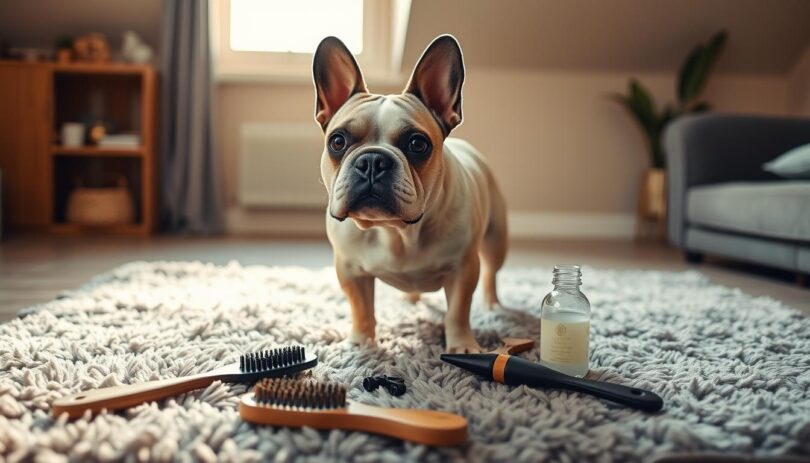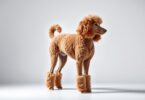If you’ve ever snuggled up with a Frenchie, you know their charm is unmatched—until you spot tiny hairs on your favorite sweater. That’s the reality of life with these affectionate companions. While their compact size and playful personalities win hearts, their shedding habits often leave owners wondering: “Is this normal?”
Short coats don’t always mean low maintenance. These dogs lose hair consistently, with heavier shedding during spring and fall. Seasonal changes trigger their undercoat to renew, leaving traces on clothes, furniture, and floors. But don’t worry—understanding their needs makes a world of difference.
This guide dives into practical strategies to manage loose fur. Regular brushing with a soft-bristle tool removes dead hair before it spreads. Baths using hypoallergenic shampoo keep their skin healthy, while omega-rich diets strengthen coat resilience. Even genetics play a role—some pups naturally shed more than others.
By blending routine care with expert insights, you’ll keep your home cleaner and your pet happier. Let’s explore how small adjustments can turn shedding from a hassle into a manageable part of life with your four-legged friend.
Introduction to French Bulldogs’ Shedding Habits
Every pet parent knows the joy of sharing life with a furry friend—and the occasional surprise of finding stray hairs on their couch. Shedding is a natural process where dogs lose old or damaged hair, and short-coated breeds like the Frenchie are no exception. While their shedding isn’t excessive compared to long-haired breeds, it happens consistently throughout the year.
Understanding the Basics of Shedding
Hair renewal keeps a dog’s coat healthy. For Frenchies, this means daily hair loss that’s barely noticeable. Their single-layer coat lacks an undercoat, which reduces overall shedding. However, factors like diet quality and skin health can affect how much hair they drop. A shiny, smooth coat often signals good nutrition and care.
Seasonal Patterns and Their Impact
Twice a year—usually in spring and fall—you might see more loose hairs. Temperature changes trigger these seasonal peaks. Spring shedding helps them stay cool, while fall shedding prepares for winter. Unlike wrinkly dogs with thicker coats, Frenchies adapt quickly to weather shifts. Regular brushing during these months minimizes fur buildup around your home.
Do French Bulldogs Shed? An In-Depth Look
Many owners notice their companion’s hair appears year-round but wonder why it spikes at certain times. This breed sheds moderately daily, with predictable surges during temperature shifts. Recognizing these patterns helps tailor care routines effectively.
All-Year Shedding vs. Seasonal Peaks
Hair renewal occurs continuously, even if it’s subtle. Unlike breeds with dense undercoats, these dogs lose small amounts daily. Their short fur clings less to surfaces, making shedding less obvious in daily life.
Warmer months often intensify the process. Heat sensitivity triggers heavier shedding as their bodies adapt to rising temperatures. This seasonal peak typically lasts 4–6 weeks, with fur dropping faster than usual. Regular brushing during this phase captures loose strands before they scatter.
Genetics and environment also influence shedding frequency. Indoor pets exposed to artificial lighting may shed inconsistently. Consistent grooming reduces visible hair accumulation, regardless of the season. A balanced diet rich in proteins and vitamins supports coat health year-round.
Understanding these cycles allows owners to anticipate needs. While shedding can’t be eliminated, proactive care keeps homes cleaner and pets more comfortable. Simple adjustments—like weekly brushing—make a noticeable difference in managing fur around the house.
Factors Influencing French Bulldog Shedding
While seasonal changes play a role in coat renewal, internal factors like nutrition and health significantly shape a Frenchie’s shedding patterns. What your pet eats and how their body reacts to allergens can either minimize or amplify hair loss.
Diet and Nutrition Impact
A high-quality diet directly supports coat health. Foods rich in proteins, omega-3 fatty acids, and vitamins like biotin strengthen hair follicles. Low-grade ingredients or fillers often trigger skin irritation, leading to excessive shedding. For example, salmon oil supplements can improve skin elasticity and reduce brittle hair.
Balanced pet food also prevents nutrient deficiencies linked to dull coats. Look for formulas with easily digestible proteins like chicken or lamb. Hydration matters too—moisture-rich diets keep skin supple and less prone to flaking.
Allergies and Health Considerations
Allergies—whether from pollen or specific proteins—often worsen shedding. Springtime brings environmental triggers like grass or mold, causing itchiness and hair loss. Food sensitivities to grains or dairy may also inflame skin, accelerating shedding cycles.
Persistent scratching or redness warrants a vet visit. Conditions like dermatitis or hormonal imbalances require targeted treatments. Owners should note that a healthy French Bulldog lifespan correlates with proactive allergy management and routine checkups.
Essential Grooming Practices for French Bulldogs
Proper grooming transforms routine care into a bonding experience while controlling stray hairs. Focused attention on brushing and bathing creates healthier skin and minimizes shedding surprises. Let’s explore two pillars of effective coat maintenance.
Brushing Techniques and Frequency
A soft-bristle brush or rubber grooming mitt works best for short coats. Glide the tool in the direction of hair growth 2–3 times weekly to lift dead strands. This rhythm prevents matting and distributes natural oils evenly.
Avoid stiff brushes that scratch sensitive skin. Over-brushing can cause irritation, leading to increased scratching and hair loss. Always pair sessions with treats to create positive associations.
When and How to Bathe Your Frenchie
Limit baths to every 6–8 weeks using lukewarm water and hypoallergenic shampoo. Lather gently around folds, rinsing thoroughly to prevent residue buildup. Post-bath, pat the coat dry with microfiber towels before using a low-heat blow dryer.
Never leave moisture in skin creases—this invites infections. Finish with a light brushing to remove any loosened hairs. Consistent routines keep the coat glossy and reduce seasonal shedding spikes.
Best Grooming Tools and Products
Effective grooming starts with the right arsenal of tools designed for short, smooth coats. Specialized equipment captures loose hairs efficiently while keeping your pet comfortable. Let’s explore which products deliver results without compromising skin health.
Recommended Brushes and Combs
A rubber grooming mitt works wonders for short-haired breeds. Its gentle texture massages the skin while lifting dead hairs. For deeper cleaning, the Furminator deShedding Tool removes trapped undercoat layers without tugging—ideal for seasonal shedding peaks.
Soft-bristle brushes distribute natural oils evenly, promoting shine. Avoid stiff bristles that scratch sensitive areas. Always clean tools after each session to prevent bacteria buildup. A quick rinse with mild soap maintains hygiene and performance.
Many Frenchie owners praise silicone deshedding gloves for their dual-purpose design. They allow hands-on brushing during cuddle time, reducing stress for pets. Pair these with a fine-tooth comb to tackle stubborn patches behind ears or tail folds.
Expert communities emphasize tool quality over quantity. Investing in durable, hypoallergenic options minimizes irritation and long-term costs. Consistent use of these products keeps coats healthy and homes fur-free.
Tips to Reduce Excessive Shedding
Managing loose fur doesn’t require magic—just smart strategies tailored to your pet’s needs. By combining daily habits with targeted care, you’ll notice fewer hairs on furniture and floors. Focus on consistency and gentle methods to keep your companion comfortable while minimizing cleanup.
Maintaining a Regular Brushing Routine
Brush your pet 3 times weekly using a rubber grooming mitt. Start at the neck, moving downward in smooth strokes to collect loose hairs. This 5-minute session prevents dead fur from spreading across your home.
Pair brushing with playtime to create positive associations. Offer treats afterward to reinforce calm behavior. Avoid pressing too hard—gentle pressure is enough to stimulate natural oils without irritating skin.
Effective Bathing and Drying Methods
Schedule baths every 6 weeks using oatmeal-based shampoo. Lukewarm water and a handheld sprayer make rinsing easier. Massage the lather into the coat for 2 minutes before thoroughly washing it out.
Dry folds carefully with microfiber towels first. Use a blow dryer on cool settings, holding it 12 inches from the body. Finish with a quick brush to remove any remaining loose hairs. This routine helps reduce shedding while keeping skin healthy.
Maintaining a Healthy Coat and Skin
A lustrous coat starts from within, where nutrition plays a starring role in skin and fur vitality. What your pet eats directly impacts hair strength, hydration levels, and overall shine. High-quality ingredients like salmon oil or flaxseed deliver omega fatty acids that combat dryness and flakiness.
Supplementing the Diet with Omega Fatty Acids
Omega-3 and omega-6 fatty acids are essential for maintaining skin elasticity and coat resilience. These nutrients reduce inflammation, soothe irritation, and lock in moisture. Supplements added to meals—like fish oil capsules or liquid blends—offer concentrated doses that enhance fur texture over time.
A balanced diet rich in proteins and vitamins supports consistent hair growth. Look for foods with chicken, sweet potatoes, or chia seeds to boost nutrient intake. Regular vet consultations help tailor meal plans to address specific skin sensitivities or deficiencies.
Owners often notice fewer loose hairs after incorporating omega-rich options. Healthier coats shed less visibly, while hydrated skin minimizes excessive scratching. Pairing smart nutrition with grooming routines creates a holistic approach to managing fur around your home.
Special Considerations for French Bulldog Owners
French Bulldog companions often face unique challenges tied to their physical traits. While their wrinkled skin and compact build add character, these features also demand attentive care. Owners must balance affection with proactive health strategies to keep their pets comfortable.
Managing Allergies and Sensitive Skin
No dog breed is fully hypoallergenic, including French Bulldogs. Their dander and saliva can trigger reactions in sensitive individuals. Weekly wipe-downs with hypoallergenic pet wipes reduce allergen buildup on coats and skin folds.
Skin sensitivity in this breed often stems from environmental irritants or food triggers. Opt for fragrance-free shampoos and oatmeal-based conditioners during baths. These products soothe irritation without stripping natural oils.
Diet plays a crucial role in managing skin health. Limited-ingredient foods with novel proteins like duck or venison help identify allergens. Omega-3 supplements strengthen skin barriers, reducing flare-ups from pollen or dust mites.
Persistent scratching or redness warrants a veterinary dermatologist’s input. They might recommend allergy testing or medicated creams. Early intervention prevents secondary infections in delicate skin areas.
Owners should vacuum frequently using HEPA filters and wash pet bedding in hot water. These steps minimize airborne allergens while supporting their companion’s comfort. With tailored care, French Bulldogs thrive despite their sensitivities.
Debunking Common Myths About Bulldog Shedding
Many assume short-haired dogs leave no trace of fur around the house—until reality hits. Contrary to popular belief, French Bulldogs experience consistent shedding year-round. Let’s separate fact from fiction using insights from veterinary studies and breed experts.
Myth: “They hardly shed because of their coat length.” Truth? Their short fur doesn’t prevent natural hair renewal. While less noticeable than long-haired breeds, loose hair still accumulates on fabrics and floors. The American Kennel Club confirms all dogs shed—it’s about quantity, not presence.
Another misconception suggests seasonal changes eliminate shedding needs. In reality, temperature shifts only intensify natural patterns. Daily brushing remains essential regardless of the month. Studies show consistent grooming reduces visible fur by 40% compared to irregular routines.
Owners often question if “bulldogs shed” differently than other breeds. English Bulldogs may drop more hair due to thicker coats, but Frenchies follow similar biological processes. The key difference lies in fur texture and distribution patterns.
Practical solutions exist for managing stray hairs. Vacuuming twice weekly and using washable furniture covers minimize cleanup. Pair these habits with monthly de-shedding treatments to maintain a tidy home. Remember: shedding signals healthy skin renewal—not neglect.
Enhancing Your Frenchie's Overall Grooming Routine
Transforming grooming from a chore into a joyful ritual strengthens your bond while keeping their coat healthy. Advanced techniques focus on comfort and cooperation, turning sessions into moments both of you anticipate.
Creating Positive Grooming Experiences
Start by pairing brushing with high-value rewards like freeze-dried liver treats. Offer these during and after sessions to build excitement. Calming music or pheromone sprays in the room can ease anxiety for sensitive pets.
Use silicone lick mats smeared with peanut butter during nail trims or baths. This distracts them while associating grooming with tasty rewards. Gentle handling—like massaging ears before cleaning—builds trust over time.
Consistency matters more than duration. Five-minute daily brush-outs work better than hour-long monthly marathons. Rotate between tools: a rubber mitt one day, a soft bristle brush the next to keep things novel.
Adapt your approach based on their mood. Skip the blow-dryer if they tense up—opt for air-drying instead. Products like oatmeal-infused wipes make quick cleanups stress-free between full baths.
Owners report success with lavender-scented grooming gloves or puzzle toys during sessions. These small tweaks reduce resistance while maintaining skin health. Over time, your companion may even nudge you toward their brush!
Final Thoughts on Caring for Your French Bulldog’s Coat
A shiny coat isn’t just about looks—it’s a window into your dog’s overall health. By combining weekly brushing, nutrient-rich meals, and regular baths, you’ll keep loose fur under control while supporting skin vitality. Remember: consistency matters more than perfection.
Quality diets packed with omega fatty acids strengthen hair follicles, reducing excessive shedding. Pair this with gentle grooming tools like rubber mitts or soft-bristle brushes to maintain a sleek, healthy appearance. Every Frenchie is unique, so experiment with routines to find what works best.
While no breed is hypoallergenic, proactive care minimizes allergens and stray hairs. Stay patient if challenges arise—small adjustments often lead to big improvements. Your commitment to their well-being ensures a happier companion and a cleaner home.
For deeper insights, consult your vet or explore trusted pet care resources. With the right approach, you’ll turn coat maintenance into a rewarding part of life with your four-legged friend.
FAQ
Are French Bulldogs considered hypoallergenic?
No, Frenchies aren’t hypoallergenic. They shed moderately year-round, which can trigger allergies. Regular grooming and cleaning routines help minimize dander and loose hair in your home.
How often should I brush my Frenchie’s coat?
Brush your Frenchie 2–3 times weekly using a soft-bristle brush or rubber grooming mitt. During seasonal peaks (spring/fall), increase brushing to daily sessions to manage excess hair.
Can diet reduce shedding in French Bulldogs?
Yes. High-quality food rich in omega-3 and omega-6 fatty acids supports skin health and reduces shedding. Brands like Royal Canin or Hill’s Science Diet offer formulas tailored for sensitive skin.










Leave a Comment